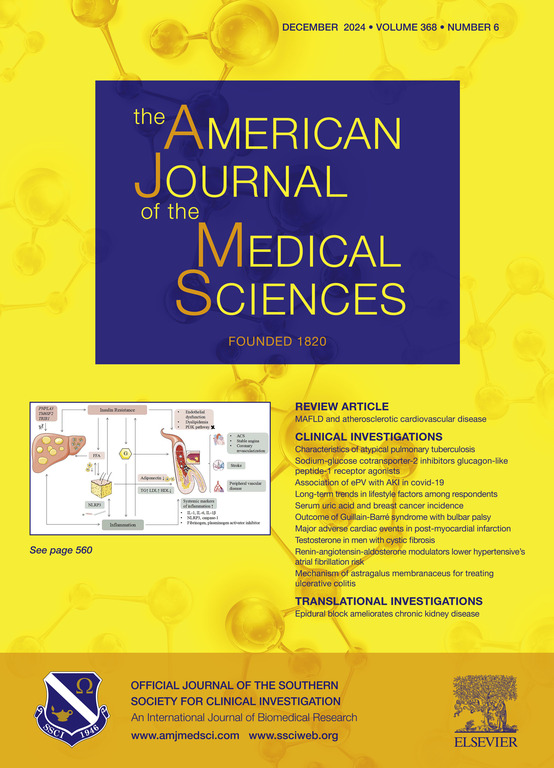Effect of different shock conditions on mesenteric hemodynamics
IF 2.3
4区 医学
Q2 MEDICINE, GENERAL & INTERNAL
引用次数: 0
Abstract
Background
Reduced effective circulating blood volume and impaired peripheral tissue perfusion play an important role in the pathophysiology of shock. However, there have been no studies examining the relationship between Doppler ultrasound of the superior mesenteric artery (SMA) under different shock conditions.
Methods
We evaluated a total of 85 patients, including 63 patients with different types of shock and 22 in the control group. we included patients who were diagnosed with shock upon admission or developed shock during their hospital stay. At the same time, patients with stable hemodynamics, no use of vasoactive drugs and normal lactate levels were used as a control group. We collected SMA Doppler ultrasound parameters, including Peak Systolic Velocity (PSV), End Diastolic Velocity (EDV), Resistance Index (RI), pulsatility index (PI), Time-Averaged Mean Velocity (TAMV), and Blood Flow (BF).
Results
In the cardiac shock group, SMA PSV, TAMV, and BF were lower compared to the other groups. There was no significant difference in SMA RI and PI between the different types of shock groups, but both were significantly lower than the control group. Cardiac index (CI) is correlated with SMA PSV (r = 0.487, P = 0.000) and TAMV (r = 0.538, P = 0.000), whereas SVRI is not correlated with SMA RI and PI. Lactate levels was correlation with SMA RI (r = -0.307, P = 0.000) and PI (r = -0.287, P = 0.000). The area under the ROC curve of SMA RI and PI to predict hyperlactatemia was 0.85[0.78–0.91] and 0.83[0.76–0.90].
Conclusions
The velocity parameters of SMA Doppler ultrasound such as TAMV and PSV can reflect cardiac function. The measurements of SMA RI and PI are correlated with lactate levels, having a positive predictive value for hyperlactatemia and provide guidance for fluid resuscitation in patients with shock in the future.
不同冲击条件对肠系膜血液动力学的影响。
背景:有效循环血容量减少和外周组织灌注受损在休克的病理生理学中起着重要作用。然而,目前还没有研究探讨在不同休克条件下肠系膜上动脉(SMA)多普勒超声之间的关系:我们共对 85 名患者进行了评估,其中包括 63 名不同类型的休克患者和 22 名对照组患者。同时,将血液动力学稳定、未使用血管活性药物且乳酸水平正常的患者作为对照组。我们收集了SMA多普勒超声参数,包括收缩峰值速度(PSV)、舒张末期速度(EDV)、阻力指数(RI)、搏动指数(PI)、时间平均平均速度(TAMV)和血流量(BF):在心脏休克组,SMA PSV、TAMV 和 BF 均低于其他组。不同类型休克组的 SMA RI 和 PI 无明显差异,但均明显低于对照组。心脏指数(CI)与 SMA PSV(r = 0.487,P = 0.000)和 TAMV(r = 0.538,P = 0.000)相关,而 SVRI 与 SMA RI 和 PI 无关。乳酸水平与 SMA RI(r = -0.307,P = 0.000)和 PI(r = -0.287,P = 0.000)相关。SMA RI 和 PI 预测高乳酸血症的 ROC 曲线下面积分别为 0.85[0.78-0.91] 和 0.83[0.76-0.90]:结论:SMA多普勒超声的速度参数,如TAMV和PSV,可以反映心脏功能。SMA的RI和PI测量值与乳酸水平相关,对高乳酸血症具有积极的预测价值,可为今后休克患者的液体复苏提供指导。
本文章由计算机程序翻译,如有差异,请以英文原文为准。
求助全文
约1分钟内获得全文
求助全文
来源期刊
CiteScore
4.40
自引率
0.00%
发文量
303
审稿时长
1.5 months
期刊介绍:
The American Journal of The Medical Sciences (AJMS), founded in 1820, is the 2nd oldest medical journal in the United States. The AJMS is the official journal of the Southern Society for Clinical Investigation (SSCI). The SSCI is dedicated to the advancement of medical research and the exchange of knowledge, information and ideas. Its members are committed to mentoring future generations of medical investigators and promoting careers in academic medicine. The AJMS publishes, on a monthly basis, peer-reviewed articles in the field of internal medicine and its subspecialties, which include:
Original clinical and basic science investigations
Review articles
Online Images in the Medical Sciences
Special Features Include:
Patient-Centered Focused Reviews
History of Medicine
The Science of Medical Education.

 求助内容:
求助内容: 应助结果提醒方式:
应助结果提醒方式:


